

|
|
NATURE NOTES FROM ACADIA
By Arthur Stupka, Park Naturalist SECTION II. DECIDUOUS TREES 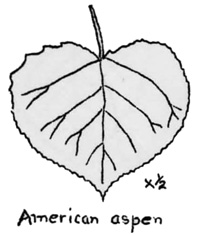
Both the American aspen (Populus tremuloides) and the
large-toothed aspen (P. grandidentata) are common soft wood trees
in Acadia National Park. After forests have been burned or cut-over

The balsam poplar (Populus balsamifera) is closely related to the two species just discussed. Its broadly ovate leaves are margined with fine blunt teeth. The brown, sticky, aromatic winter buds give the tree its name. Like the aspens, the balsam poplar is a soft-wood hardy tree of rapid growth. It is fairly common in the towns near the park. 
Although easily recognized as a group, the willows (Salix sp.), like the asters and goldenrods, are distinguished from one another with considerable difficulty. Even the trained botanists sometimes fail to agree as to their proper specific or sub-specific names. Willows are trees or shrubs which usually grow along streamsides. Their leaves are often narrow and tapering and their flowers appear in early spring. Over a dozen species and subspecies are to be found growing on Mount Desert Island. The hop hornbeam (Ostrya virginiana), a small slender tree
which grows in cool shaded places, is rather uncommon in this region.
Its grayish-brown bark is thin and roughened into rather loose
longitudinal strips. The fruit it bears is hop-like in appearance, the
little seeds being inclosed in small inflated bags. The leaves, two to
The yellow birch (Betula lutea), largest of our native birches, is immediately recognized by the brassy or golden color of its bark. Trees growing in the open tend to start branching from near the base while those in close stands are often free of lateral branches for a considerable distance. Its smooth leaves are narrower than those of the canoe birch. Although not as abundant as the canoe birch, it is, however, a common deciduous tree in the park. A so-called "weed tree" is the graceful little gray birch (B. populifolia), growing where other trees have not yet established a foothold. Frequently it is confused with its taller-growing cousin, the canoe birch. The facts that the bark of the gray birch does not peel off in thin paper-like scales and that its somewhat smaller leaves are roughly triangular in outline should help to identify it. This pioneer tree often grows in close clumps. Along the highway near the summit of Cadillac Mountain the tourist is struck by the wind-swept twisted condition of an extensive stand of this birch.
The canoe birch (B. papyrifera), also known as white or paper birch, is undoubtedly one of the most beautiful trees in the Acadian forest. Singly or in groves, this white-barked, slender, tall-growing tree is attractive at all seasons. It served the Indian in so many ways that we readily associate this abundant species with the vanishing red man. Although attaining its best growth in the rich soil along margins of streams and lakes and on wooded hillslopes, it may be found in a variety of habitats. Its leaves, two to three inches in length, are ovate in outline, sharply toothed along the margins, and terminate in a sharp point. In the spring the two-or three-clustered staminate or male flowers (catkins) appear before the leaves. Three alders are to be found growing on Mount Desert Island. Of these, the green (Alnus alnobetula) and the speckled alders (A. incana) are common whereas the smooth alder (A. rugosa) is rare. All are rather small shrubs which often form thickets in favorable habitats. Their small cone-like woody fruits are characteristic and in the spring they, like the hazel and the birches, dangle their catkins in the breeze.
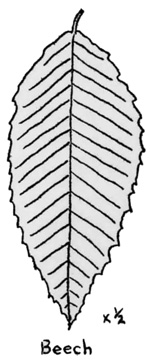
Sturdy, tall-growing, and distinguished in bearing, the beech (Fagus grandifolia) is one of the very finest of our deciduous trees. Its smooth gray somewhat mottled bark; its thin silken leaves with their straight parallel veins; its sweet triangular fruits inclosed within small prickly burs; its very slender, sharp pointed, reddish-brown buds - all these are characteristic of the beech, a common tree in Acadia National Park. Of the oaks or acorn-bearing trees, but two species are native to
Mount Desert Island. Of these the red oak (Quercus borealis) is
by far the most abundant and grows wherever the soil is fairly well
drained. It is a large tree which, when growing in the open, has a broad
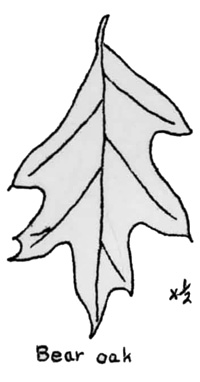
The American elm (Ulmus americana) is uncommon here. It is a
large handsome symmetrical tree with thick roughened gray bark and ovate
leaves which are unequal at the base. It prefers to grow in bottomlands
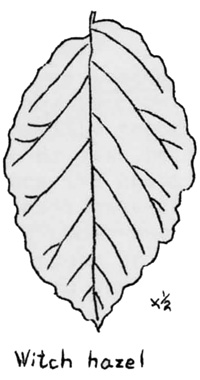
Whether we call the witch hazel (Hamamelis virginiana) a shrub or a small tree doesn't matter, it remains one of our most interesting plants. Its broad oval leaves have wavy margins and an uneven base, and the plant seems to prefer to send its roots into fairly moist rocky soils. Strangely enough, the witch hazel unfurls its golden flower ribbons in autumn, bearing its mature fruits at the same time, the flowers of this year producing the fruits of the next. Its seeds are scattered by a bombardment from the oval nut-like capsules. The witch hazel extract of commerce is made from the bark of roots and young twigs. 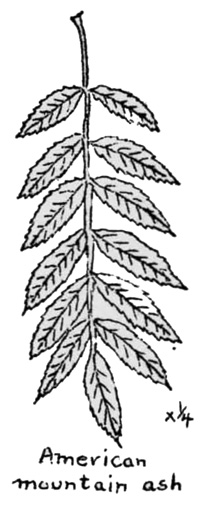
Both the American mountain ash (Sorbus americana) and the variety known as the western mountain ash (S. americana sitchensis) grow in Acadia National Park. The former is a common small tree which grows on rocky hillsides and in rather moist situations. Its compound leaves are made up of 11-17 lanceolate and sharply serrate leaflets which give the tree a somewhat "ferny" appearance. Its large, showy, flat-topped berry clusters, bright orange to red in color, may persist into the winter. On Mount Desert Island grosbeaks, starlings, robins, and other birds often feed upon the brightly-colored fruits to such an extent that these may disappear before the end of the year. 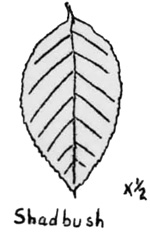
Two species of shadbush (Amelanchier canadensis and A. laevis) are to be found in this region. This beautiful small tree, sometimes going by other common names such as sugar pear, Juneberry, and service berry, is shrubby in growth and prefers open situations, often growing along stream-sides or at the edge of the forest. Its very showy attractive white blossoms appear in May, when the leaves are just beginning to unfold. These are followed by small purplish fruits which ripen in mid-summer and which are in great favor with birds and various fur-bearers, including man. 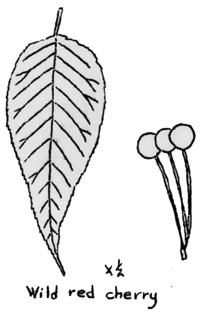
Three cherries grow in this region. Of these the small wild red or fire cherry (Prunus pennsylvanica) is very common, growing well in rocky soil. It flowers in May, and its attractive bright red sour fruits ripen in mid-summer. The chokecherry (P. virginiana) is a common low-growing shrubby tree along fence rows and, to some extent, in woods. It fruits more abundantly than the previous species, the fruit, astringent and darker in color, being arranged in drooping clusters. The wild black cherry (P. serotina) grows to be a larger tree than the two preceding species. Its white flowers, like those of the chokecherry, are borne in drooping racemes - those of the fire cherry are borne in umbels. Fruits of the wild black cherry are dark, almost black in color. This tree is uncommon in the region. All our cherries have oval to oblong-lanceolate sharp-pointed leaves whose margins are finely serrate. Their fruits form an important food item for certain birds and for some fur-bearers, including man. The staghorn (Rhus hirta) is our only native sumac. It is small and shrubby in growth and prefers fairly dry upland habitats. This attractive shrub is readily recognized by its long compound leaves which are made up of from 11 to more than twice that number of leaflets, by the dark velvety pubescence which covers its stout twigs, and by its persistent reddish fruits which are arranged in erect cone-like clusters. The leaflets, dark green above with considerably paler under-surfaces, are oblong and tapering, with serrate margins. Few of our shrubs or small trees become arrayed in brighter autumnal colors than the staghorn sumac. It is not poisonous.
(To be continued in the next issue) |
| <<< Previous | > Cover < | Next >>> |
nature_notes/acad/vol3-2b.htm
09-Jan-2006